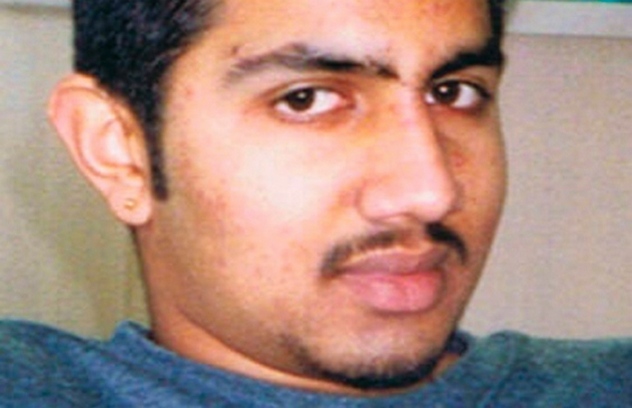 Music
Music  Music
Music  History
History 10 Less Than Jolly Events That Occurred on December 25
 Weird Stuff
Weird Stuff 10 Funny Ways That Researchers Overthink Christmas
 Politics
Politics 10 Political Scandals That Sent Crowds Into the Streets
 Weird Stuff
Weird Stuff Ten Bizarre Facts About The Doge Meme
 Our World
Our World 10 Ways Your Christmas Tree Is More Lit Than You Think
 Movies and TV
Movies and TV The 10 Coolest Stars to Set Sail on The Love Boat
 History
History 10 Things You Didn’t Know About the American National Anthem
 Technology
Technology Top 10 Everyday Tech Buzzwords That Hide a Darker Past
 Humans
Humans 10 Everyday Human Behaviors That Are Actually Survival Instincts
 Music
Music 10 Surprising Origin Stories of Your Favorite Holiday Songs
 History
History 10 Less Than Jolly Events That Occurred on December 25
 Weird Stuff
Weird Stuff 10 Funny Ways That Researchers Overthink Christmas
Who's Behind Listverse?

Jamie Frater
Head Editor
Jamie founded Listverse due to an insatiable desire to share fascinating, obscure, and bizarre facts. He has been a guest speaker on numerous national radio and television stations and is a five time published author.
More About Us Politics
Politics 10 Political Scandals That Sent Crowds Into the Streets
 Weird Stuff
Weird Stuff Ten Bizarre Facts About The Doge Meme
 Our World
Our World 10 Ways Your Christmas Tree Is More Lit Than You Think
 Movies and TV
Movies and TV The 10 Coolest Stars to Set Sail on The Love Boat
 History
History 10 Things You Didn’t Know About the American National Anthem
 Technology
Technology Top 10 Everyday Tech Buzzwords That Hide a Darker Past
 Humans
Humans 10 Everyday Human Behaviors That Are Actually Survival Instincts
10 Unsolved Cases That Involved Mysterious Phone Calls
Watch the video on YouTube: 10 Unsolved Cases That Involved Mysterious Phone Calls
When it comes to phone calls, they are generally easy to track. Caller ID is a pretty common feature, and phone companies keep records of who calls whom. It even appears that the NSA is tracking all the calls that people make. Yet, with these mysteries, there are phone calls that are immensely puzzling.
10The Kuykendall Family Harasser

In February 2007, in Fircrest, Washington, 16-year-old Courtney Kuykendall’s phone started sending out random text messages to her friends. Things got weird when someone started calling the members of the Kuykendall family. The caller threatened to kill them, kill their pets, and kill their grandparents. The Kuykendalls contacted the police, and the calls were traced back to Courtney’s phone. Of course, the obvious suspect was Courtney. The problem was that the calls continued even when Courtney’s phone was turned off or when her parents had taken it away from her.
Things only got creepier from there. Whoever was calling described things the Kuykendall family were doing or what they were wearing. The stalker left voice mails that were recordings of conversations they had, even the one when the police had visited to talk about the calls. This continued for over four months, and no suspect was ever found. The cell phone company didn’t think the technology to hijack a phone existed at the time. However, security experts said a phone could have been hijacked using spyware. The police thought that the family could have been making the story up, but two other families in the town also reported similar problems with their cell phones.
9Charles Peck’s Ghost Calls

On September 12, 2008, a Metrolink commuter train collided head-on with a Union Pacific freight train in the Chatsworth area of Los Angeles. The engineer of the Metrolink train was considered at fault, because it looked like he was sending a text message at the time of the crash. The crash was the worst in the history of the Metrolink—25 died, and another 135 people were injured.
One of the people who lost their lives was 49-year-old Charles Peck, who was in Los Angeles for a job interview with the Van Nuys Airport. Peck wanted to move to California, because his fiance lived there. He was apparently killed almost instantly, because he was close to the spot of the impact and was one of the last people to be pulled out of the wreckage.
What is really mysterious is that, throughout the night and up until his body was discovered, Peck’s phone called a number of people, including his sons, his fiance, and his brother. All the calls were a few seconds of silence before hanging up. While nobody’s sure how the calls were made, there are some people who believe it was Peck’s spirit calling his loved ones to say goodbye.
8The Disappearance Of Dale Williams

Dale Williams, 42, owned a body shop in Nucla, Colorado. On May 27, 1999, a stranded motorist called for help. Williams’s friend, who was at the shop, thought that the caller was female from the way Williams was talking. Williams seemed to be in a normal mood when he left, but the weird thing was that Williams wasn’t a mechanic, so he didn’t usually go out on many calls. Yet, he left in the company truck, and that was the last confirmed sighting of him. Five weeks later, the truck was found where the San Miguel River and the Dolores River meet. The truck was in gear, and the ignition was on. Also, the window was half-open, which his wife thought was strange, because he always drove with the window all the way down.
One suspect was a former friend of Williams’s. Williams and his wife had helped the former friend’s wife move, and they refused to tell him where they had moved her. Evidence that pointed to this former friend included torn-up pictures of Williams and the former friend’s family. They also found .22 caliber bullets around the shop. Williams’s wife ran a video store, and someone had dropped off a .22 caliber gun in the video return box after Williams had gone missing. Both the pictures and the gun had come from Williams’s shop. The police interviewed the former friend, but he denied any involvement. Williams has never been found, and no one has ever been arrested in connection with the crime. The identity of the caller also remains a mystery.
7The Disappearance Of Balraj Rattu

The last confirmed sighting of 19-year-old Balraj Rattu was on November 6, 1995. He was seen sitting in a car, drinking a beer with a friend in Surrey, British Columbia. Three days later, his car was found about an hour away in Chilliwack, British Columbia. It was burned to the ground, and there were bloody clothes in it, but there was no sign of the 19-year-old man.
The day after he went missing, at 1:06 AM, a young woman called his family’s home. She thought that she was talking to Rattu and said, “Raj, you were beaten up.” Then she started laughing and hung up. The next day, there was another caller, whom Rattu’s father described as an older woman. She told them that Rattu was dead and then hung up. Both callers spoke Punjabi, and Rattu’s father is convinced they were two different callers.
Police are unsure what happened to Rattu. His body has never been found. He wasn’t associated with drugs or gangs, but it is suspected he was a victim of foul play. The police were unable to trace the calls, and the identity of the mysterious callers remains unknown.
6The Missing Crew Of Casie Nicole

On April 11, 1990, Nathan Neesmith, his brother Billy Joe Neesmith, his nephew Keith Wilkes, and his friend Franklin Brantley set off from McIntosh County pier in Georgia to go on a seven-day commercial fishing expedition. Their ship, Casie Nicole, had just recently been docked for maintenance. They took it to an uncharted reef off the coast of South Carolina. Early in the morning on April 12, their boat capsized and quickly took on water. They had to abandon the ship, so they boarded a raft. Nathan Neesmith left the other three men in the raft with some food and went off in a wooden box to go find help. He was rescued five days later, but the rest of the men were never found. The only things ever found were a sleeping bag and a life vest.
One probable conclusion was that the men simply drowned at sea. While that is wholly possible, there were strange phone calls from a man who didn’t speak English, which made the families of the missing men think they were still alive. Starting about six weeks after the disappearance and continuing over the next year, there were seven calls made in all. Four were made to Nathan’s sister, and the other three were made to a man named Doug Tyson, the owner of Casie Nicole. The caller would just repeat the phone number, say the name of the person he was calling and the name of one of the missing men, Billy Joe. In the last call, the man said he was going to bring them home. However, the men were never seen again.
The phone calls led the family to speculate that the men were actually rescued from the ocean but were being held captive in a foreign country. Yet, there is little evidence that helps shed light on what actually happened to the three fishermen.
5The Strange Case Of ‘L’enfant’

The Marrakesh is a Moroccan restaurant in Washington, D.C. Starting in 1983, it was the target of a campaign of harassment by an unknown individual or a group of people. The workers at the restaurant simply referred to the caller as “L’enfant” (“the Young One”). Sometimes, L’enfant called with death threats. Other times, he just swore or would get very sexual. He also did characters. He pretended to be a Middle Eastern man, a small black child, and a little girl, just to name a few. He would call the restaurant multiple times, almost every day. Getting 20 phone calls in a day wasn’t unusual for the restaurant. The crazy thing is that this went on for over a decade. During one especially busy period—which lasted for about four years—the restaurant received over 7,000 phone calls.
As a result, there was a high turnover rate at the restaurant. People got sick of dealing with L’enfant. However, no one was affected nearly as much as Bashir Kouchacji, the manager of the restaurant. Kouchacji believed that he was the target of L’enfant, and it stems from an incident in 1974, when he was in Beirut. The Palestine Liberation Army kidnapped Kouchacji, because they thought he was a spy for the Mossad or a CIA agent. He was held in a Palestinian refugee camp, where he was threatened daily. After attempting suicide, he was sent to the hospital, where he was able to get in contact with his family. They contacted the American Embassy, and he was finally released.
When he was back in the US, Kouchacji and his sister opened the first Marrakesh restaurant in Philadelphia. Once it was successful, they decided to open a second one in Washington. That’s when the phone calls started. At first, it was just laughter or someone saying “tsk tsk.” It escalated from there and got so bad that Kouchacji became an angry and paranoid man. He lost lovers, friends, and employees over it. For years, he was in and out of psychiatric hospitals. Other evidence that Kouchacji points to is that his car was vandalized with the Star of David, his former girlfriend was threatened, and the phone calls followed him when he visited the Philadelphia restaurant. The phone company and the FBI both tried to establish the identity of whoever was making the calls, but the only thing they could tell was that the calls came from pay phones all over the D.C. area. After 10 years, the phone calls were still happening but were less frequent.
4The Murder Of Tracey Kirkpatrick

Tracey Kirkpatrick was a responsible 17-year-old who planned on going to school to become a lawyer. On March 15, 1989, she was working alone in a women’s sportswear store in Frederick, Maryland. Her manager stopped by the store at 8:00 PM. At 10:50 PM, a security guard was checking the shopping center and saw that the lights in the store were still on, so he went to investigate. In the storage room, he found Kirkpatrick dead from stab wounds to the chest and neck. The police were stumped as to who would kill the teenager, because the crime seemed motiveless. There was no sign of sexual assault and the store wasn’t robbed, but Kirkpatrick’s purse was gone.
The case went cold, but three months after the murder, a strange potential clue emerged. A man, who identified himself as “Don,” called a confession hotline. The hotline, which was based in Las Vegas, charged people per minute to confess their secrets and then charged others to call in and listen to those confessions. “Don,” who said he was from Frederick, Maryland, claimed he stabbed a young girl and thought about turning himself in, but he didn’t. He said he was sorry, but he couldn’t do anything to change what happened. Then he hung up.
The hotline sent a copy of the recording to the police, and it was also sent to radio stations in the hope that someone would recognize his voice. However, since “Don” didn’t specify that he murdered Kirkpatrick, it’s unclear if he is her murderer or a killer at all. The police had two viable suspects throughout the years, but no one has ever been charged in the murder of the 17-year-old honor student.
3The Abduction And Murder Of Amy Mihaljevic
On April 27, 1989, a police officer had come to the class of 10-year-old Amy Mihaljevic to talk about how you should never go anywhere with a stranger. The problem was that the man who abducted and murdered Amy was not a stranger to her. They had talked over the phone a few times. Her brother overheard one conversation her sister had with a mystery man. Amy even told her friends about him, but she didn’t tell her parents or any other adults that a grown man was calling her. On that tragic day, Amy told a friend she was meeting her secret caller to go buy her mother a present. The man claimed to work with her mother and told Amy her mother had just been given a promotion. After school, Amy and a friend walked together until Amy went off to meet the mysterious man.
After Amy had met the man, he allowed her to call her mother, who assumed that Amy was calling from home. It was only after she arrived home that she realized that Amy had never been there. A frantic search of Bay Village, Ohio was done. But sadly, the little girl’s body was not found until February 7, 1990. Her head had signs of trauma, and it appeared that she was probably sexually assaulted and stabbed. It also looked like the body was dumped a short time after she was kidnapped. The barbaric murder made national headlines and was featured on America’s Most Wanted. Yet, no one has ever been arrested in connection with the crime. Investigators are still hoping to track down the mystery caller.
2The Caller Who Predicted John F. Kennedy’s Assassination

On November 22, 1963, just after 10:00 AM, a switchboard operator at General Electric in Oxnard, California answered a call. There was no one talking on the line, but since the caller could have been in some sort of trouble, the operator asked a coworker to pick up as well. That’s when the caller whispered that the President would be killed at 10:10 AM. The caller, who sounded like a middle-aged woman reading things out loud, whispered some other warnings, such as “The justice. The Supreme Court. There’s going to be fire in all the windows. The government is going up in flames.” Also during the call, the caller placed the phone down and dialed 12–15 digits. The operator asked if she needed any help, and the woman responded in a clear voice, “No. I’m using the phone.”
Another call, made after 10:10 AM, insisted that the President was going to be killed at 10:30 AM. At 10:25 AM, they disconnected the call, thinking the caller was just a disturbed individual. Meanwhile, in Dallas, Texas, President John F. Kennedy was driving down Elm Street. The shots that killed the President were fired at 12:30 PM Central Time, meaning the time in California was 10:30 AM—exactly the time the caller mentioned. The phone company reported the call about an hour after the President was shot, and the FBI wrote a report about it. They were unable to trace the call, although the FBI still believes it was just a disturbed woman.
1The Long Island Serial Killer
Along a remote stretch of the Ocean Parkway in Long Island, the bodies of 14 women have been found. All of the women were associated with the sex trade, and the police believe that at least 10 of the bodies were dumped there by one man, known only as the “Long Island Serial Killer.”
The unknown serial killer is believed to have gotten his start in 1996, but the first four bodies were not found until December 2010. Then, six more bodies were found between April and May 2011. All the women have been strangled and wrapped in a burlap sack before being dumped. There have been four other bodies found in the same area. However, they do not seem to match the other killings, so the police do not think the same man is responsible.
Besides murdering the women, the killer also found a sadistic way to torment the family of one of his victims. On July 10, 2009, 24-year-old Melissa Barthelemy went missing. Shortly after that, Melissa’s younger sister, Amanda, started getting phone calls from her sister’s cell phone. Seven calls were made in all, and none of them lasted more than three minutes. The last call, which lasted about 40 seconds, took place on August 26, 2009, at 1:00 in the morning. During the call, the unidentified caller admitted he killed Melissa. Melissa was one of the bodies found in December 2010. The Long Island Serial Killer has yet to be identified and remains at large.
Robert Grimminck is a Canadian crime-fiction writer. You can follow him on Facebook, on Twitter, or visit his website.








